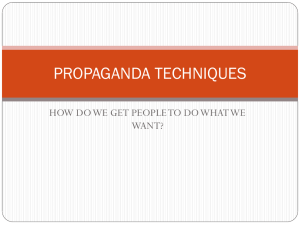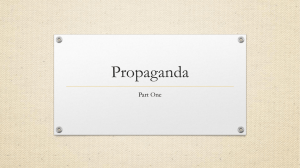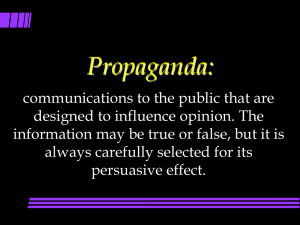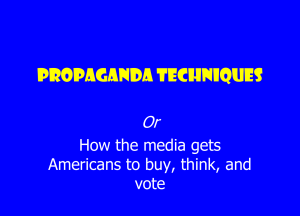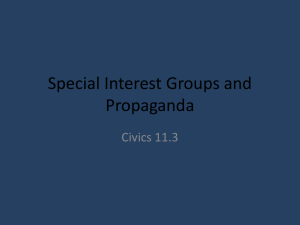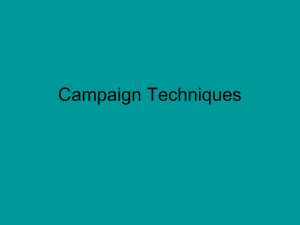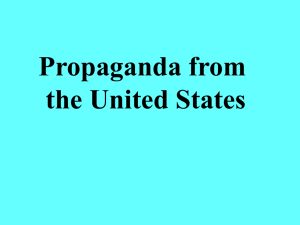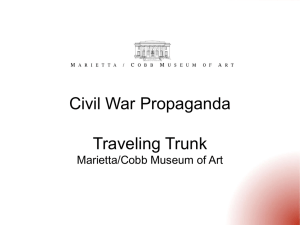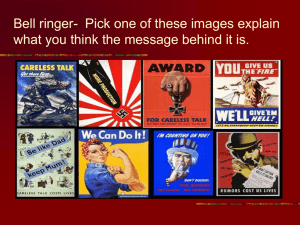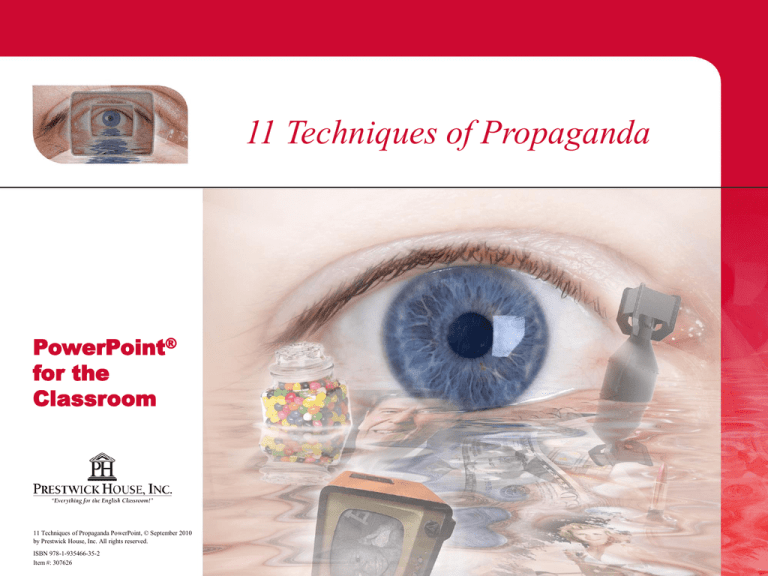
11 Techniques of Propaganda
PowerPoint®
for the
Classroom
11 Techniques of Propaganda PowerPoint, © September 2010
by Prestwick House, Inc. All rights reserved.
ISBN 978-1-935466-35-2
Item #: 307626
Table of Contents
What is Propaganda?
Back to Contents
What is Propaganda?
Have you ever had a dramatic change of heart or a strong emotional
response after looking at something as simple as a billboard or a
commercial?
If so, you may have been looking at propaganda.
Back to Contents
What is Propaganda?
Propaganda is a kind of persuasive and widespread message designed
to represent the interests of a particular group.
It attempts to bypass logic through faulty reasoning and emotional
appeals.
It can be found anywhere from the newspaper to the Internet to your
favorite TV sitcom.
Back to Contents
What is Propaganda?
Propaganda is intended to give someone else control over your
thoughts and actions.
That’s why it is crucial to be able to identify propaganda when you
see it.
Back to Contents
What is Propaganda?
Propaganda comes in many forms, but it always has the following
characteristics:
persuasive function
sizeable target audience
representation of a specific group’s agenda
use of faulty reasoning and/or emotional appeals
Back to Contents
What is Propaganda?
Propaganda often provokes instinctive emotional responses that lead
people to draw hasty conclusions.
This poster appeals to feelings of pity and guilt.
Back to Contents
What is Propaganda?
Similarly, this poster appeals not to logic, but to fear and anger.
Rather than suggesting a specific course of action, the poster simply describes
a frightening scenario.
Back to Contents
What is Propaganda?
The previous examples of propaganda were created during World War
II. However, propaganda can still be found today, all over the world.
The same approach that convinces us to buy a certain brand of
toothpaste one day may be used the next day to incite nuclear war. That
is why it is important to know how to recognize and analyze
propaganda.
Back to Contents
What is Propaganda?
In the slides that follow, we’ll look at eleven of the most basic
categories of propaganda:
Assertion
Bandwagon
Card Stacking
Glittering Generalities
False Dilemma
The Lesser of Two Evils
Back to Contents
Name-Calling
Pinpointing the Enemy
Plain Folk
Testimonials
Transfer
What is Propaganda?
By the end of this presentation, you should be equipped to detect and
analyze most of the propaganda you encounter in the real world.
Back to Contents
Discussion Topics
Discussion Topics
1. What are some potential sources of propaganda in the modern
world?
Sources include commercials, billboards, print ads (catalogues,
magazines, direct mail, etc.), and political campaigns, among many
others.
Back to Contents
Discussion Topics
2. In order to qualify as propaganda, a message must meet the
following criteria:
persuasive function
sizeable target audience
representation of a specific group’s agenda
use of faulty reasoning and/or emotional appeals
Describe an example of a message that would meet all but one of the
above criteria. Explain your answer.
Back to Contents
Discussion Topics
(Discussion Topic #2 continued)
Describe an example of a message that would meet all but one of the
above criteria. Explain your answer.
Example: A high school assembly called to discuss the dangers of
drunk driving may meet the following criteria: 1) persuasive function
(persuading students not to drive drunk), 2) sizeable target audience
(the entire high school), 3) representation of a specific group’s agenda
(the school board’s desire to protect the school’s image). Nevertheless,
the argument against drunk driving may be based on sound reasoning
and facts, rather than emotional appeals and logical fallacies.
Back to Contents
Discussion Topics
3. Identify an example of propaganda you have recently been exposed
to, and explain to the class why this message constitutes
propaganda.
Answer will vary.
Back to Contents
Techniques
Back to Contents
Part 1: Assertion
Back to Contents
Part 1: Assertion
Assertion is the simplest form of propaganda. It consists of simply
stating a debatable idea as a fact, with no explanation or justification.
The Middle East will never be at peace.
A record number of hurricanes have been
caused by global warming this year.
Back to Contents
Part 1: Assertion
Assertion relies on the premise that people are essentially gullible and
like to believe what they are told.
Women are bad drivers.
Men never stop to ask for directions.
Back to Contents
Part 1: Assertion
Assertion is sometimes used in political or military propaganda, as in this
illustration from World War I.
Back to Contents
Part 1: Assertion
Unfounded assertions are also common in commercial advertising.
Fulmer’s Glue: making life better since 1926
Dogs that eat Nutri-Chow have more energy.
Back to Contents
Part 1: Assertion
Think about how many advertisements include phrases like the
following, without any justification:
the best product available
the most popular brand
with a taste that will never let you down
Back to Contents
Part 1: Assertion
Assertion is a quick and easy way to gain a foothold in people’s minds
in political matters as well.
This German World War II poster makes the assertion that “Europe’s victory
is your prosperity” without explaining this claim.
Back to Contents
Part 1: Assertion
George Orwell’s fictional study of propaganda and mind control, 1984,
contains an example of the assertion technique. In the novel, the
following three slogans of “the Party” are emblazoned on the walls of
the Ministry of Truth building:
WAR IS PEACE
FREEDOM IS SLAVERY
IGNORANCE IS STRENGTH
Back to Contents
Part 1: Assertion
Propaganda that uses assertions often suggests a course of action. This poster
encourages readers to “sacrifice for freedom” based on the assertion that
“This world cannot exist half slave and half free.”
Back to Contents
Part 1: Assertion
Often, an assertion will be supported by “facts” that are not
necessarily true.
This level of assertion is sometimes used to mislead people in a way
that is potentially harmful.
The scientific evidence, taken as a whole, is insufficient to establish
that other people’s tobacco smoke is a cause of any disease.
— Imperial Tobacco Group
Back to Contents
Part 1: Assertion
As you assess any given assertion, keep in mind the four qualifying
characteristics of propaganda:
persuasive function
sizeable target audience
representation of a specific group’s agenda
use of faulty reasoning and/or emotional appeals
Back to Contents
Discussion Topics
Discussion Topics
1. What makes a statement an example of “assertion” propaganda?
In addition to meeting all the criteria of propaganda, a statement must
present a debatable idea as a fact without explaining or justifying the
claim in order to constitute assertion propaganda.
Back to Contents
Discussion Topics
2. Describe an example of an assertion you have seen in politics or
advertising. Do you think that this claim has affected your point of
view? Explain your reaction.
Answer will vary.
Back to Contents
Discussion Topics
3. Identify which of the following assertions qualify as propaganda,
and explain your answer. Modify those that are not propaganda to
make them fit the four criteria.
A. Parent to child: “If you eat your vegetables, you’ll grow up to be
big and strong.”
Must be modified to target a larger audience.
Back to Contents
Discussion Topics
(Discussion Topic #3 continued)
B. Billboard: “Mario’s Pizza, Next Exit.”
This is merely a statement of fact. Must be modified to make an
unjustified claim about the restaurant (e.g., “Mario’s Pizza: The Best
Pizza in the World”).
C. Magazine ad for “age-defying” makeup: “True Beauty is
Ageless.”
Propaganda. This is an unjustified assertion, made to a large audience,
that appeals to the viewers’ feelings in order to advance the
advertiser’s agenda.
Back to Contents
Discussion Topics
(Discussion Topic #3 continued)
D. Commercial: “According to a study by the National Heart
Association, eating this cereal, as part of a balanced breakfast,
may reduce the risk of heart disease.”
This is merely a statement of facts, and must be modified to make an
unjustified claim about the cereal (e.g., “eating this cereal will reduce
your risk of heart disease”).
E. Political commentator: “Richard Williams obviously doesn’t have
the experience it takes to be President of the United States.”
Propaganda—assuming this statement is not explained with a logical
argument.
Back to Contents
Discussion Topics
4. Identify the audience and purpose for this poster, and discuss
whether this is an example of assertion propaganda.
Back to Contents
Discussion Topics
(Discussion Topic #4 continued)
4. Identify the audience and purpose for this poster, and discuss
whether this is an example of assertion propaganda.
Aimed at an American audience (during World War II), this poster
was intended to dissuade citizens from discussing military affairs.
This slogan can be considered an example of assertion propaganda;
however, the qualifier “might” opens this question to debate. If
students emphasize the use of “might” in the poster, they can argue
that this is a reasonable claim.
Back to Contents
Part 2: Bandwagon
Back to Contents
Part 2: Bandwagon
People generally like to feel that they belong to a group, especially one
that appears to be successful and popular. The bandwagon technique
manipulates people by appealing to this desire.
The term “bandwagon” has its origins in the 1800s, when politicians
used wagons with music and entertainment to attract audiences. Once a
sizeable crowd had gathered to listen to the band, a politician would
speak. Other politicians would often try to get a seat on a popular
bandwagon, hoping to take advantage of its success.
Back to Contents
Part 2: Bandwagon
The phrase “jumping on the bandwagon” was used to describe this
phenomenon, and eventually the term was used outside the political
realm.
In modern usage, the term “bandwagon effect” refers to any situation
in which people attempt to be part of a successful or popular endeavor
merely for the sake of its popularity.
Five million members and growing!
Thousands of satisfied customers can’t be wrong.
Back to Contents
Part 2: Bandwagon
You may have experienced this persuasive approach in the form of peer
pressure.
“Everybody’s doing it!”
Propaganda often uses the same illogical appeal.
Back to Contents
Part 2: Bandwagon
This German poster reads, “All the people say yes on April 10th!” The
suggestion is that, since everyone else is supposedly voting “yes,” you
should, too.
Back to Contents
Part 2: Bandwagon
The bandwagon technique can be seen in a number of different
scenarios.
It may be used casually, on a topic that’s not particularly controversial.
Everyone knows that the Grand Canyon is the most
beautiful place in North America.
Back to Contents
Part 2: Bandwagon
It can be used to validate a moral claim:
More and more couples are living together without
being married, so it must be all right.
Similarly, the bandwagon technique can be used to promote a
candidate or a product:
The Jackson campaign has the popularity it
takes to win the election.
Choose the top-selling truck in its class.
Back to Contents
Part 2: Bandwagon
The bandwagon technique is especially visible in product marketing.
Advertisers will try to convince you that by failing to do what
“everyone else” is doing or use the product “everyone else” is using,
you are missing out.
Join the digital revolution.
Back to Contents
Part 2: Bandwagon
This World War I poster depicts sailors from Japan, France, the United States,
Britain, Russia, and Italy as a happy band of brothers. It seems to suggest that
everyone is enlisting in the navy, and those who don’t should feel left out.
Back to Contents
Part 2: Bandwagon
In the sciences, the bandwagon technique is often used as a way to
gain mainstream acceptance of a given theory, since the general public
may struggle to understand the science behind complex issues.
Most scientists believe global warming is a
result of human activity.
Experts agree that obesity contributes to the
development of cancer.
Back to Contents
Part 2: Bandwagon
Sometimes it does make sense to consider the majority opinion, but
only if you have reason to believe that it is founded on solid logical
evidence.
Even the most reasonable opinions can be wrong, however, and even
“scientific” bandwagon appeals should always be subjected to scrutiny.
Scientists agree that the sun revolves around the earth.
More and more doctors are recommending that their
patients smoke cigarettes.
Back to Contents
Part 2: Bandwagon
The bandwagon technique is sometimes used in defense of claims that
are true. However, regardless of the truth of the claims, any argument
that relies on the bandwagon effect is based on flawed logic. Truth
should be conveyed using logical arguments, not merely by appeals
to an idea’s popularity.
For example, take the following statement:
Most people believe that gravity exists; therefore, gravity exists.
Back to Contents
Part 2: Bandwagon
The conclusion that gravity exists is true. Nevertheless, the logic that
led to this conclusion was flawed. The law of gravity is not subject to
popular approval; it exists independent of human beliefs.
Remember to look at the underlying logic of any argument, and judge
that logic on its own merits, rather than depending on the opinions of
the masses. If one individual can be wrong, a group of individuals can
also be wrong—no matter what advertisers may tell you.
Back to Contents
Discussion Topics
Discussion Topics
1. What makes the bandwagon technique appealing to most people?
Answers will vary.
Back to Contents
Discussion Topics
2. Identify a decision you have made based primarily on popular
opinion. Describe the situation, and explain whether following the
majority made sense in that context.
Answers will vary.
Back to Contents
Discussion Topics
3. Does the fact that numerous experts agree about a theory constitute
logical grounds for accepting it? Why, or why not?
Answers will vary.
Back to Contents
Discussion Topics
4. Identify the audience and purpose for this poster, and discuss
whether this is an example of bandwagon propaganda.
Back to Contents
Discussion Topics
(Discussion Topic #4 continued)
4. Identify the audience and purpose for this poster, and discuss
whether this is an example of bandwagon propaganda.
Aimed at the British public (during World War I), this poster was
meant to encourage citizens to enlist in the armed services. The
phrase “all answer the call” qualifies the poster as an example of
bandwagon propaganda.
Back to Contents
Part 3: Card Stacking
Back to Contents
Part 3: Card Stacking
Card stacking is a technique in which the propagandist gives an unfair
advantage to one point of view, while presenting the counterpoint in its
weakest form, if at all.
While arguments that use the card stacking technique are usually
honest in terms of the information shared, they may be misleading
because they present information out of context or obscure important
facts.
Back to Contents
Part 3: Card Stacking
This poster illustrates the card-stacking technique. It emphasizes the travel
and adventure involved in serving in the Marine Corps, while de-emphasizing
the considerable sacrifice required.
Back to Contents
Part 3: Card Stacking
Arguments that use card stacking can be convincing because they
often rely on sound reasoning and facts. The problem is that in this
technique, the opposing perspectives are unfairly downplayed; that is
why card stacking is sometimes referred to as a “sin of omission.”
Example:
A pharmaceutical company wants to test a new drug and advertises its
need for volunteers to participate in the study. The advertisements
emphasize the benefits of participating in the study. The drug’s possible
side effects are mentioned in passing in a speedy voiceover at the end
of the commercial.
Back to Contents
Part 3: Card Stacking
Often, a propagandist will acknowledge alternative views, but in an
oversimplified, dismissive way.
Example:
A group invites two experts on different sides of an issue to speak. The
expert invited to support one side is a well-known, eloquent speaker,
with extensive scientific credentials. The expert invited to represent the
other side is a fringe scientist, known for a number of unconventional
theories and for his loud, blustering demeanor.
Back to Contents
Part 3: Card Stacking
There is an underlying bias in this kind of debate. The person who
represents one side of the argument was chosen for his strengths, while
his opponent was chosen for his unappealing demeanor, his
unfavorable reputation, and his unconventional views, all of which are
likely to alienate some listeners.
Back to Contents
Part 3: Card Stacking
In written or visual propaganda, information that is not favorable to the
propagandist’s case may be printed in a smaller typeface or in some
way visually obscured.
When signing contracts, people are often warned to read “the fine
print.” That’s because often, the least attractive terms of a contract will
appear in small, barely legible type.
Back to Contents
Part 3: Card Stacking
Card stacking is frequently used in “before and after” pictures that
appear in advertisements for weight-loss programs. In many cases,
advertisers “stack the deck” by manipulating factors in the “before and
after” image that are not related to the individual’s weight loss.
Back to Contents
Part 3: Card Stacking
In this example, in addition to revealing the woman’s weight loss, the “after”
photograph also reveals card-stacking efforts. In the second photo, the
subject’s hair is styled differently, and she is wearing makeup and jewelry.
Back to Contents
Part 3: Card Stacking
When faced with possible instances of card stacking, ask yourself the
following questions:
Are opposing viewpoints misrepresented?
Does one side seem to be presented more
thoroughly than the other?
Does it seem that important factors are being ignored?
If the answer to any of these questions is “yes,” card stacking is
probably taking place.
Back to Contents
Discussion Topics
Discussion Topics
1. Why is it often difficult to distinguish card-stacking propaganda
from legitimate arguments?
Card stacking is not always easy to recognize as propaganda because
it often relies on facts and logic and makes mention of opposing
viewpoints.
Back to Contents
Discussion Topics
2. What clues can help you make the distinction between cardstacking propaganda and legitimate arguments?
If opposing viewpoints are either omitted altogether or unfairly
represented, you are probably looking at an example of card stacking.
Back to Contents
Discussion Topics
3. Describe the different forms card stacking takes in print
advertisements and television commercials. What kinds of products
are often advertised with card-stacking propaganda?
In print advertisements, details are often obscured in small print or in
inconspicuous colors or fonts. In audiovisual media such as television
commercials, these visual techniques of obscuring information are
often present, sometimes accompanied by speedy voiceovers detailing
drawbacks or disclaimers. Card stacking is often used in
advertisements for vehicles, cigarettes, medications, and many other
products.
Back to Contents
Discussion Topics
4. Identify the audience and purpose for this advertisement, and
discuss whether this is an example of card-stacking propaganda.
Back to Contents
Discussion Topics
(Discussion Topic #4 continued)
4. Identify the audience and purpose for this advertisement, and
discuss whether this is an example of card-stacking propaganda.
Aimed at the readers of a magazine or comic book, this advertisement
is intended to promote a book and a portraiture course. This is not an
example of card-stacking propaganda because the words in fine print
are not meant to be obscured—they simply describe the less vital
information.
Back to Contents
Part 4: Glittering Generalities
Back to Contents
Part 4: Glittering Generalities
Glittering generalities is a colorful term for the appealing but vague
words that often appear in propaganda.
This World War I poster requests billions of
dollars in the name of “Liberty.” Here,
“liberty” is a glittering generality—a pleasant
term that is used in an overly vague manner.
Back to Contents
Part 4: Glittering Generalities
Glittering generalities are frequently used in advertising. They’re also
a prominent part of political discourse. In the modern age of ten-second
sound bites, glittering generalities can make or break a product’s
reputation or a candidate’s campaign.
Example:
I stand for freedom—for a strong nation, unrivaled in the world. My
opponent believes we must compromise on these ideals, but I believe
they are our birthright.
Back to Contents
Part 4: Glittering Generalities
The propagandist will intentionally use words that carry strong positive
connotations and offer no real explanation. This 1943 Nazi poster makes the
vague, unexplained claim that “Adolf Hitler is victory!”
Back to Contents
Part 4: Glittering Generalities
Popular glittering generalities include:
freedom/liberty
security
choice
prosperity
equality
change
strength
Back to Contents
Part 4: Glittering Generalities
This poster asserts that “Americans will always fight for liberty,” without
explaining what this pleasant-sounding phrase means.
Back to Contents
Part 4: Glittering Generalities
Most advertising slogans use glittering generalities. Since slogans must
be short and to the point, advertisers frequently use vague, positive
words.
Orange Cola: made from the best ingredients on earth
Spotting glittering generalities is simply a matter of looking for vague,
positive words that are not explained. A reasonable argument, by
contrast, will justify the words being used, explaining exactly what
they mean in context and how they will be achieved.
Back to Contents
Discussion Topics
Discussion Topics
1. Glittering generalities are a common part of political campaigns.
Compose a list of glittering generalities you have heard in campaign
slogans, in debates, or in the news media.
Answers will vary.
Back to Contents
Discussion Topics
2. Like politicians and journalists, advertisers often use glittering
generalities to promote their products. Create a list of glittering
generalities that are commonly used in advertising.
Answers will vary.
Back to Contents
Discussion Topics
3. Under what conditions are words like “freedom” and “choice” not
glittering generalities? Use each word in a sentence that does not
qualify as a glittering generality.
Words like “freedom” and “choice” often qualify as glittering
generalities when they are left to stand alone, with no explanation.
However, they are not glittering generalities when they are assigned
specific meanings. For example, “freedom” is not a glittering
generality when used to describe emancipation from slavery (e.g.,
“The former slave had earned his freedom through years of hard
labor”) Likewise, “choice” is not a glittering generality when it is
used to refer to a specific kind of choice (e.g., “She was given the
choice to rewrite the paper, but she chose, instead, to accept a failing
grade”).
Back to Contents
Discussion Topics
4. Identify the audience and purpose
for this poster, and discuss whether, in
the context of this poster, Lincoln’s
words are being used as glittering
generalities. If so, which words stand
out as glittering generalities? If not,
why not?
Back to Contents
Discussion Topics
(Discussion Topic #4 continued)
4. Identify the audience and purpose for this poster, and discuss
whether, in the context of this poster, Lincoln’s words are being
used as glittering generalities. If so, which words stand out as
glittering generalities? If not, why not?
Aimed at the American public (during World War I), this poster was
meant to inspire its audience to save food. Lincoln’s words are used
as glittering generalities in the context of this poster. Words like
“charity,” “just,” and “peace” may sound admirable, but they are
given no specific definition within this passage.
Back to Contents
Part 5: False Dilemma
Back to Contents
Part 5: False Dilemma
The false dilemma is a popular technique used in propaganda. This
fallacy is known by many names, including “black-and-white
thinking,” “false dichotomy,” and “false choice.”
Most commonly, it consists of reducing a complex argument to a small
number of alternatives and concluding that only one option is
appropriate.
Back to Contents
Part 5: False Dilemma
In this kind of propaganda:
One product always works, and the other never works.
One group intends to save the country, and the other
is trying to ruin it.
Back to Contents
Part 5: False Dilemma
The view or product that the propagandist is promoting is depicted
positively, and all competition or opposing views are depicted in a
negative light.
In reality, however, there are usually many possibilities that go
unmentioned.
Back to Contents
Part 5: False Dilemma
The false-dilemma technique is used most often in political and ethical
discourse. One option is described as being good, and the other is made
to seem bad, or even evil.
The propagandist oversimplifies the situation and denies the existence
of any neutral ground.
You are either an ally or an enemy.
Back to Contents
Part 5: False Dilemma
The message of this poster from World War II is that if you don’t join a carsharing club, you are directly supporting Hitler.
Back to Contents
Part 5: False Dilemma
Advertising often makes use of the false-dilemma technique as well.
If you aren’t using White Bright Detergent, your clothes
are not clean.
You can subscribe to Propaganda Weekly, or you can
stay uninformed.
Back to Contents
Part 5: False Dilemma
The false dilemma reduces all choices to a simple matter of “either/or.”
Either you conserve gasoline, or you’re helping Hitler.
Either you purchase a security system, or you do not
love your family.
Either you use a specific brand of detergent, or you
wear filthy clothes.
Either you agree with us, or you are a fool.
Back to Contents
Part 5: False Dilemma
In the real world, of course, most issues are not so simple. There is a
spectrum of gray between black and white, and life often requires us to
make difficult decisions in a world of infinite possibilities.
Back to Contents
Discussion Topics
Discussion Topics
1. List some examples of false-dilemma arguments you have heard in
real life.
Answers will vary.
Back to Contents
Discussion Topics
2. What are some of the clues that can help you distinguish a false
dilemma from a legitimate presentation of facts?
In a false-dilemma argument, a limited number of possibilities are
presented, one of which is depicted in a far more favorable light than
the others. In a legitimate presentation of facts, by contrast, a wider
variety of options will be introduced, and each will be evaluated in an
unbiased manner.
Back to Contents
Discussion Topics
3. Following the examples provided in this section, create a falsedilemma argument to fit each of the following scenarios. (Hint:
False dilemmas often take the form of “either/or” assertions.)
• encourage recycling
• endorse a political candidate
• support a tax increase
Answers will vary.
Back to Contents
Discussion Topics
4. Identify the audience and purpose for this poster, and discuss
whether this is an example of false-dilemma propaganda.
Back to Contents
Discussion Topics
(Discussion Topic #4 continued)
4. Identify the audience and purpose for this poster, and discuss
whether this is an example of false-dilemma propaganda.
Aimed at the American public (during World War I), this poster was
meant to encourage people to buy Liberty Bonds. This is an example
of a false dilemma because it suggests that if people fail to buy bonds,
there will be no liberty left on earth.
Back to Contents
Part 6: The Lesser of Two Evils
Back to Contents
Part 6: The Lesser of Two Evils
While most false dilemmas offer a “good” and a “bad” alternative, the
lesser of two evils technique is a specific type of false dilemma that
offers two “bad” alternatives.
This technique is often used when the propagandist is trying to
convince people to adopt a perspective they will be hesitant to accept.
Back to Contents
Part 6: The Lesser of Two Evils
In order to make the choice more appealing, an even worse alternative
is presented as the only other option. It is argued that an imperfect
option is, at any rate, better than the horrendous alternative.
You don’t want to drive a fuel-efficient automobile?
Try living under a terrorist regime!
Back to Contents
Part 6: The Lesser of Two Evils
In nations like the United States, which has a de facto two-party
political system, the lesser-of-two-evils argument is often used as a
selling point for politicians.
A candidate who is unpopular within his or her party may suddenly
appear more attractive when pitted against a member of the opposing
party.
Senator Williams may have lied under oath, but at least he never
embezzled money from his campaign, as his opponent did.
Back to Contents
Part 6: The Lesser of Two Evils
In presidential elections, this tactic is frequently used to lure people
away from third-party candidates; Democrats and Republicans point
out that voting for the lesser of two evils is better than simply
“wasting” a vote on someone who will never win.
In the 2000 United States presidential election, for example, the
Democratic Party tried to use this technique with their “Nader = Bush”
bumper sticker.
The message was that a vote for the Green Party (Nader) would be the
equivalent of a vote for the Republican (Bush)—whom, it was
presumed, Green Party voters would not wish to support at all.
Back to Contents
Part 6: The Lesser of Two Evils
The lesser of two evils technique is most effective when one of the possible
choices is truly awful, as in this poster, which pits frugality against fascism.
Back to Contents
Part 6: The Lesser of Two Evils
While there are many flaws in the lesser-of-two-evils approach, the
main problem is that, like the false dilemma, it usually ignores many
alternative possibilities.
Often, adopting a lesser-of-two-evils stance discourages innovative
thinking by needlessly reducing the possible options.
Back to Contents
Part 6: The Lesser of Two Evils
It is always best to be suspicious of any message that purports to show
you the only two options available.
When you’re faced with such a choice, consider each option on its own
merits, and keep in mind that there are probably other, undisclosed
alternatives.
Back to Contents
Discussion Topics
Discussion Topics
1. How is the lesser-of-two-evils technique similar to the falsedilemma approach? What sets these techniques apart from one
another?
Like the lesser-of-two-evils approach, the false dilemma reduces a
complex situation to a limited number of possibilities. Unlike the
former technique, however, propaganda that uses the lesser-of-twoevils tactic offers two unpleasant alternatives.
Back to Contents
Discussion Topics
2. What are the keys to identifying the lesser-of-two-evils fallacy?
In the lesser-of-two-evils fallacy, a limited number of possibilities are
presented (usually two). This propaganda technique also encourages
you to make a decision based on the fear of one outcome, rather than
the merits of the other.
Back to Contents
Discussion Topics
3. The lesser-of-two-evils fallacy is often used to defend the status
quo, as exemplified in the familiar idiom, “better the devil you
know than the devil you don’t know.” Generate a list of real-life
scenarios in which this technique of propaganda is used to preserve
the status quo.
Answers will vary.
Back to Contents
Discussion Topics
4. Create a caption to go with this image that would make the poster
an example of lesser-of-two-evils propaganda.
Back to Contents
Discussion Topics
(Discussion Topic #4 continued)
4. Create a caption to go with this image that would make the poster
an example of lesser-of-two-evils propaganda.
Examples: 1) You may not want to spend your summer building a
fallout shelter, but it’s better than dying of radiation poisoning.
2) Maybe you won’t be able to afford a vacation this year, but that’s a
small price to pay for protecting your family against nuclear attacks.
3) It may not be pretty, but it’s better than living in a nuclear
wasteland.
Back to Contents

